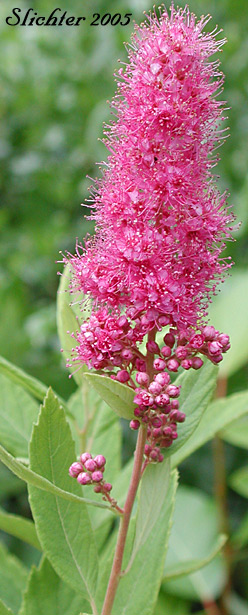

Douglas spiraea or hardhack is a deciduous shrub from 1-2.5 m in height. In open areas, the new growth consists of many thin, vertical, unbranched stems. The stems are less than 1 cm thick, brittle, with many old leaf nodes that give it a knobby appearance. The new bark is a shiny brown to purple-brown. Older branches have thin, shredding bark.
The leaves are simple with pinnate venation and alternate in appearance on the stems. They are oval to oblong in shape with toothed margins from the midpoint to the tip, and range from 4-6 cm in length. The upper leaf surfaces may appear dark green or glaucous, while the undersides range from slightly hairy to woolly and light in color.
The inflorescence is an elongated, densely flowered spike or panicle of pink flowers from 6-20 cm long. The flowers have 5 pink to rose colored petals, the petals each orbicular-elliptic to obovate in shape and 1-5-2 mm long. The seed heads remain intact throughout the winter, leaving a distinct, dark brown cluster at the terminus of the stems.
Hardhack sees some use as an ornamental shrub in moist landscapes. It is valuable as cover and nesting habitat for many birds. The seed heads provide food for small birds and mammals, while the twigs and leaves may be browsed by the larger herbivores. Due to its dense growth, it may hinder the survival of other wetland species. Its dense growth pattern also prevents intrusion into wetlands by humans or livestock.
Hardhack is found in moist, sunny areas from sea level to subalpine habitats. It is found in damp meadows, swamps, bogs, streambanks, lake margins, and in ditches. It is shade-intolerant and can survive lengthy shallow inundation when the water table raises.
Hardhack may be found from southern Alaska south along the Pacific coast to northern California, and east in southern British Columbia to northern and central Idaho, northeastern Washington, and into northeast Oregon. It is commonly found in the Cascades.